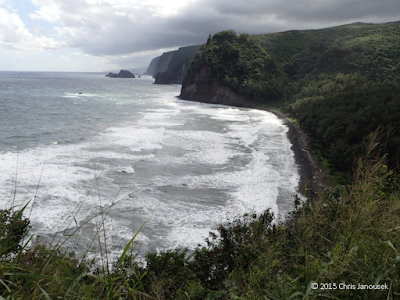 |
| Geographic regions of the Big Island. Map source |
The northwestern district of Kohala and the Hamakua coast
were among the final regions we visited while making a loop around the Big Island Hilo coasts, scattered
only with small towns, farms, and impressive vistas of open space. There are a
series of green valleys sculpted into the northeast-facing coast of Hamakua , largely inaccessible except by hiking.
From the North Kohala side, at the terminus of state road 270,
is Pololu Valley California in some degree, like the rough coastal gem of
the Big Sur area.
 |
| The northwest coast of Hamakua from the overlook above Waipio Valley. A waterfall nearly reaches the beach. |
Down in Pololu
Valley Hawaii .
With some help from the kids, we gathered up a number of items to remove them
from the beach.
Pollution is a distinctly visible reminder of humankind’s
impact to our most cherished natural areas. It is particularly unwelcome on our
beautiful coastlines. Yet, visibility aside, it is probably one of the lesser
human impacts to the oceans. Habitat destruction, overfishing (which disrupts
entire food webs), and changing climate are perhaps more pernicious threats to
ocean biodiversity and function.
 |
| Pololu Valley. |
 |
| A black cobble beach at Pololu Valley and the cliffs of the Hamakua coast in the distance. |
Flying for hours over the vast Pacific, the immensity of the
global ocean is made apparent. Individually, we are barely specks on this
immense globe, so it is perhaps natural to assume that our species can have
little impact on this globe. Yet evidence from every line of science points
otherwise. When tsumani debris bearing living organisms arrives on the shores
of Oregon from Japan (as I was able to observe firsthand a few years ago), it
becomes apparent just how close supposed distant places are to each other. Our
collective human impacts on our planet have become pervasive.
 |
| The kids helped gather marine debris washed ashore at Pololu Valley. |
 |
| Coastal topography near Pololu Valley, from 1995 USGS topographic map, Honokane, HI. |
Reference
Barth S. 1995. The Smithsonian Guides to Natural America . The
Pacific. Smithsonian Books, Washington
D.C.
No comments:
Post a Comment